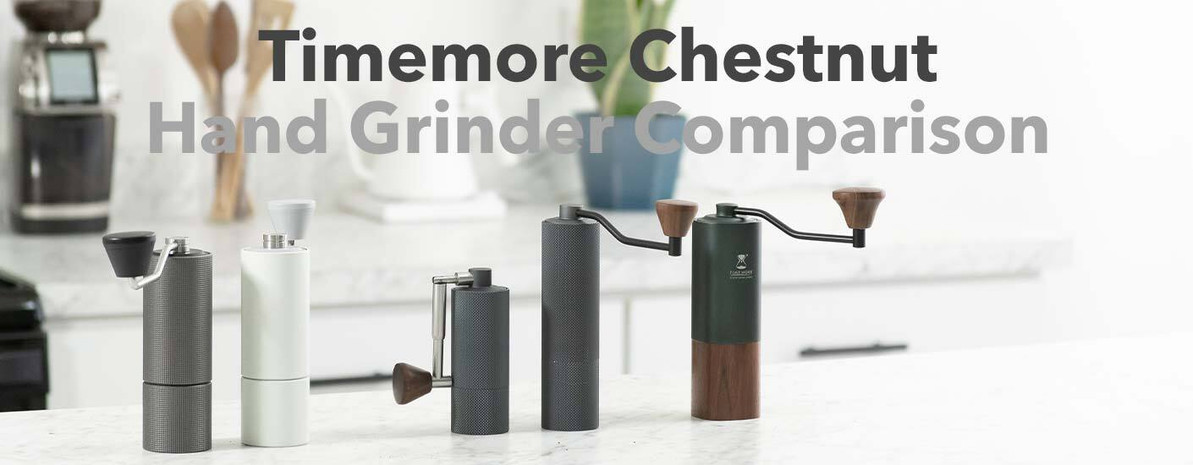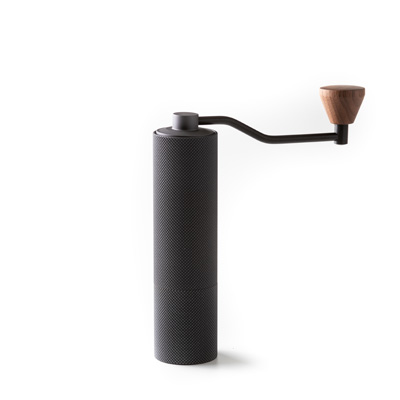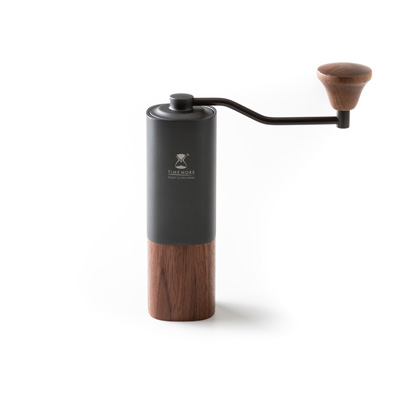Product Comparison | Timemore Chestnut Hand Grinders
The Timemore Chestnut line-up includes a manual grinder for most purposes and budgets. In this video, Steve discusses each model in turn, from the most affordable C2, to the travel-friendly Slim and NANO, to the handsome G1, paying special attention to the features that differentiate each and ending with an example of the grind quality from the two available burr sets.
Transcript
Timemore Chestnut Slim Manual Coffee GrinderCompact Grinder With Premium Grind
Featured Product
Timemore Chestnut G1 Manual Coffee GrinderDesigned For Professional Quality
Featured Product
Hi, I'm Steve with Prima Coffee. And today, we're going to talk about all the products in Timemore's new Chestnut line of manual grinders. These are all the grinders in the lineup, and they fall into three categories: Entry level, travel friendly, and ultra modern. The C2 is the entry level grinder. It comes in these two finishes. There's a powder-coated white, which is smooth. And then there's this gray checkered pattern that is raised, so it's a nice grippable texture. In the middle, we have the NANO and the Slim. And they have the same diamond pattern texture, and it gives it a great grip as well, and the same diameter, only about an inch and a half across, making them really suitable for travel. And this one is the G1. It is the most unique grinder in this product line, and it stands apart because of the modern design and because of its larger hopper capacity. So that is the broad view.
The big difference between these grinders will be in the burrs. Timemore makes their own 38-millimeter stainless steel burrs that work best grinding in the medium-fine and coarser, so Chemex and that area. They work great for pour over as well, but not fine enough to produce sufficient fines to make proper espresso. Those burrs come standard in the C2. The Slim, on the other hand, comes with 38-millimeter stainless steel burrs coated in titanium. So, they're way more effective in the finer grind, meaning, theoretically, you can grind for espresso. The titanium-coated burrs have more and flatter cutting surfaces at the top of the burr, where the initial breaking of the beans occurs. This appears to create more fines, but also makes for a more efficient grinding experience. So, it takes about half as long to grind with those burrs as opposed to the stainless steel burrs. There's one caveat for espresso, which I'll talk about later.
So, the NANO here and the G1, they come with your choice of burrs. So, the titanium-coated burrs, they're a bit more expensive, but they're probably worth it if you prefer brewing methods like moka pot, and espresso, and also, if you just want to spend less time grinding. So, this isn't to say that you cannot grind medium or coarse range with the titanium-coated stainless steel burrs. You can. However, we have found that our taste tests that the stainless steel burrs always make it cleaner, more articulate V60 and Chemex. So, all that is to say that the burr is the greatest decision you have when you're looking to buy one of the grinders in the Timemore line. The other differences are in the parts, not in the mechanics. The C2 is the only grinder that has plastic parts. The lid, the pommel here, and the interior of the grinds catch where these supports are, those are all plastic. The drive shaft, however, the dual bearings, the crank arm, and the burrs are all stainless steel. So, the difference here are in the preference for aesthetics, not in the grind quality, which is still quite good.
The NANO and the Slim are all metal with this one wood accent. So, an aluminum body, which includes those supports, it's all one piece, the grinds catch, and for the drive shaft, the bearings, and the crank arm, those are all stainless steel. And it has this nice wood pommel that you can take off, little magnet inside and it snaps right back on. So, the difference between these two, besides the size, is in this handle. So, the Slim uses the same handle as the other ones. It's ergonomic design. The NANO is special though, because it comes with this retractable and collapsible handle. So, what you do is you just pull here on that middle segment, and it'll fall against the body, right? And there's this rubber bumper on the backside to keep it from scratching up the grinder when it does that. The NANO can be folded down to five inches tall, three inches wide when you collapse the handle and take off the pommel. So, you throw that in your suitcase. I mean, it's just really travel-friendly. That said, the Slim is still a good option for travel. It's just two inches taller. It's same diameter when you remove the crank arm.
So, it can still be folded down and put into a bag and thrown in your suitcase and travel with, though it just takes up a little more space. Not much. The notable difference is in the hopper size. So, the NANO can fit 15 grams to 19 grams of coffee compared to the slim, which is 20 to 25 grams. So, when we experiment, we use light roasted beans, and we had no trouble getting to those high numbers, although it was kind of tight. So, if you want to make two-cup batches for V60 or even Chemex, the NANO is probably not for you, unless you don't mind grinding multiple batches. For context, the C2 can fit roughly 30 grams, and the G1 can fit about 30 or a little more. With the G1, Timemore deviated from the cylindrical shape of the other ones. They went for sort of rounded cuboid shape. The outside is nearly squared off, but the inside diameter is round, much like the other ones here. The grinds catch is different from the other ones, both in its material, it uses black walnut, and in its connection.
The other ones have a threaded connection whereas this one has four grooves on the inside that connects to these four balls. So, it just goes like that. The pommel is also black walnut, like the Slim and the NANO, but it is marginally larger. So, the rest of the materials are metal. It's a unibody aluminum design which includes the supports on the inside, aluminum on the interior of the grinds catch, and aluminum lid. It's stainless steel for the crank arm, the drive shaft, and the bearings. Also, it is the only grinder in the lineup with the Timemore logo right there on the center. So, all these grinders use a step adjustment wheel. The only real difference you will find is that the C2 has a plastic dial, whereas the other models here have a metal dial. There are 12 dots on the perimeter here, and they help you recall the grinding position for any one brew style. So, you just turn the dial all the way down to the right, and they call that zero point.
So, the burrs at that point are touching, you should not be able to move the crank arm, okay? Then you turn the wheel to the left, counterclockwise here, and you count the clicks or the dots that you pass until you reach the recommendation. So, they say 6 to 12 clicks for espresso, 15 to 24 for pour over, and 24 and above for French press. We have found this to be almost right. It usually takes about eight clicks before any coffee will go all the way through the burrs into the grinds chamber. We found eight and nine to be good places for espresso with the titanium-coated burrs. However, keep in mind that this is a stepped adjustment. So, our experience was that the shots with eight were too fast and the shots with nine were too slow, and there is no eight and a half. So, there's no dialing in with the stepped adjustment wheel. Keep that in mind. Also, keep in mind that the grinding differs with each burr set. So, as you get further away from the zero point, the differences between the burr sets become more visible. The titanium-coated burrs always seem to produce finer grinds when set to the same number of clicks as the stainless steel burrs. We always had to go a few clicks more than what we do with the stainless steel burrs with those titanium-coated burrs.
So, for a visual, I've ground on 8 clicks, 15 clicks, and 24 clicks as Timemore's recommendations for espresso, pour over, and French press with both the stainless steel burrs and with the titanium-coated stainless steel burrs to give you an idea of what to expect with each. So, as you can see, the titanium-coated burr set is finer, and there's sort of a pulverized quality to some of it, whereas the stainless steel produced a higher uniformity. Even though there are some fines, there isn't that pulverized quality. That said, the grind quality is above average, if not exceptional for both sets. And perhaps, what is more important is the grind quality is remarkable for this price point on all of the grinders in this line. So that is the new Timemore lineup of manual grinders. The C2 is the most affordable and also the lightest. The NANO and the Slim are travel-friendly, and they're also really comfortable to hold. And then over here, the G1 is the most unique in both of its materials and its design. You can find them all online at primacoffee.com. Thanks for watching.







